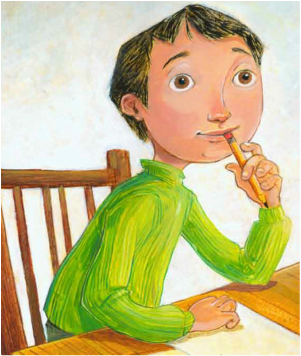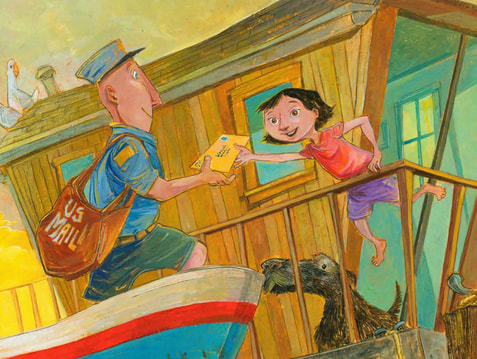Need writing advice? I'm here to help both child and grown-up writers! Read on for some publishing tips I've learned along my author journey.
For child writers...
|
When I visit schools, I often meet kids who write stories and draw pictures. They will ask, "How can I get my story (or picture) published?" The best way is to send your work to a children's magazine. Many of them publish works by children. Here's what to do:
1. Go to the library. (Can't get there? No worries! CLICK HERE to send your work to the children's magazine, Highlights. It's one of my favorites.) 2. Visit the children's magazine section. Find a magazine that publishes works by children, then look for instructions (also called guidelines) on how to send in your work. If you can't find instructions, ask a librarian for help. 3. Next, mail your work to the address provided. It will take time for the magazine to respond, so try to wait patiently. Being patient is the hardest part. |
4. Finally, you will get a letter from the magazine. It means the magazine's editors saw your work! In the letter, the editors may say they are: (a) publishing it; or (b) not publishing it at this time. Either way, they want you to keep sending in your stories, poems, and illustrations. Know why? Creating stuff is hard work. (Sometimes, it's even harder than being patient.) They know that, and they're proud of you for working hard. So am I.
If you need help with storytelling, look no further! I've been lucky enough to hear from young authors who have shared these writing resources:
From Anna: CLICK HERE for information about scriptwriting. Find out how to write a play for a stage production, even a screenplay for a TV show or feature film. There are also links to examples of scripts and screenplays.
From Eric: CLICK HERE to learn about copywriting, the legal way that authors can prevent someone from stealing their work. Copywriting also protects the work of filmmakers, musicians and other kinds of artists.
From Jaymee: CLICK HERE for a creative writing glossary. It gives the definitions of important story elements like setting, plot, and conflict. See the end of the glossary for even more resources.
From Marisa: CLICK HERE for oodles of resources on how to build your writing skills, how to format and edit your manuscript, which careers are out there for writers, and a LOT more. It's really reader-friendly, too.
From Willow: CLICK HERE for awesome online tools that will make you an expert editor. Checking your writing for clichés (overused words) and turning brainstorm mishmash into an organized story outline are just two of the many ways these tools can help!
Good luck, and keep creating!
If you need help with storytelling, look no further! I've been lucky enough to hear from young authors who have shared these writing resources:
From Anna: CLICK HERE for information about scriptwriting. Find out how to write a play for a stage production, even a screenplay for a TV show or feature film. There are also links to examples of scripts and screenplays.
From Eric: CLICK HERE to learn about copywriting, the legal way that authors can prevent someone from stealing their work. Copywriting also protects the work of filmmakers, musicians and other kinds of artists.
From Jaymee: CLICK HERE for a creative writing glossary. It gives the definitions of important story elements like setting, plot, and conflict. See the end of the glossary for even more resources.
From Marisa: CLICK HERE for oodles of resources on how to build your writing skills, how to format and edit your manuscript, which careers are out there for writers, and a LOT more. It's really reader-friendly, too.
From Willow: CLICK HERE for awesome online tools that will make you an expert editor. Checking your writing for clichés (overused words) and turning brainstorm mishmash into an organized story outline are just two of the many ways these tools can help!
Good luck, and keep creating!
For grown-up writers...
|
It's my pleasure to help guide you toward publication! Sometimes, writers will apologize for reaching out as if their email is completely interrupting my day. It isn't in the least, so never apologize! Here are some tips to nudge you in the right direction:
1. Join the Society of Children's Book Writers and Illustrators (SCBWI). As a member, you will get loads of opportunities to network with like-minded people. There are local and national workshops, conferences, and meetings, all to hone your craft. I've been a member of SCBWI for years now and really value my membership. 2. Do you write picture books? Chapter books? Study the style of book you're writing. No matter what I write (picture books, rhyming picture books, early chapter books, etc.), I always study other books in that category. Specifically, I'll pay attention to the book's story arc, pacing, sentence structure, and vocabulary. I take note of the word count too! (To check the word count of a book, use AR BookFinder.) Studying similar books will help you get your work into competitive shape. |
3. Most all children's books need three things: (1) a main character (who's usually a child or a childlike character), (2) a problem, and (3) a resolution. Be sure to include them in your story.
4. If you're writing a picture book, find a book that is similar to your vision and type it out on Word. Press ENTER to show every page break. Doing so can help you see how fast/slow a story moves; that way, you can apply a similar pace to your own story.
5. Ready to submit your work? You may wonder whether to contact a children's literary agent or a publisher. Many publishers are closed to unsolicited submissions, so try focusing your efforts on finding a literary agent. In my experience, a literary agent is an essential guide on the road to publication.
When you get published, a new challenge awaits: Promoting your book! It can shake up your expectations in an important way, and I talk about how in my guest blog post for Writer's Digest, "What to expect when you're promoting: Why a first-time author changed her expectation."
Do you have any other publishing questions? Reach out to me at [email protected]. Meantime, keep writing!
4. If you're writing a picture book, find a book that is similar to your vision and type it out on Word. Press ENTER to show every page break. Doing so can help you see how fast/slow a story moves; that way, you can apply a similar pace to your own story.
5. Ready to submit your work? You may wonder whether to contact a children's literary agent or a publisher. Many publishers are closed to unsolicited submissions, so try focusing your efforts on finding a literary agent. In my experience, a literary agent is an essential guide on the road to publication.
When you get published, a new challenge awaits: Promoting your book! It can shake up your expectations in an important way, and I talk about how in my guest blog post for Writer's Digest, "What to expect when you're promoting: Why a first-time author changed her expectation."
Do you have any other publishing questions? Reach out to me at [email protected]. Meantime, keep writing!


